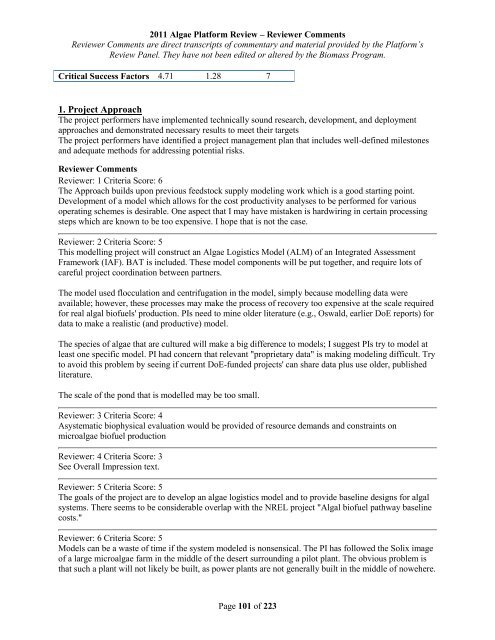Reviewer Comments - EERE
Reviewer Comments - EERE
Reviewer Comments - EERE
Create successful ePaper yourself
Turn your PDF publications into a flip-book with our unique Google optimized e-Paper software.
2011 Algae Platform Review – <strong>Reviewer</strong> <strong>Comments</strong><br />
<strong>Reviewer</strong> <strong>Comments</strong> are direct transcripts of commentary and material provided by the Platform’s<br />
Review Panel. They have not been edited or altered by the Biomass Program.<br />
Critical Success Factors 4.71 1.28 7<br />
1. Project Approach<br />
The project performers have implemented technically sound research, development, and deployment<br />
approaches and demonstrated necessary results to meet their targets<br />
The project performers have identified a project management plan that includes well-defined milestones<br />
and adequate methods for addressing potential risks.<br />
<strong>Reviewer</strong> <strong>Comments</strong><br />
<strong>Reviewer</strong>: 1 Criteria Score: 6<br />
The Approach builds upon previous feedstock supply modeling work which is a good starting point.<br />
Development of a model which allows for the cost productivity analyses to be performed for various<br />
operating schemes is desirable. One aspect that I may have mistaken is hardwiring in certain processing<br />
steps which are known to be too expensive. I hope that is not the case.<br />
<strong>Reviewer</strong>: 2 Criteria Score: 5<br />
This modelling project will construct an Algae Logistics Model (ALM) of an Integrated Assessment<br />
Framework (IAF). BAT is included. These model components will be put together, and require lots of<br />
careful project coordination between partners.<br />
The model used flocculation and centrifugation in the model, simply because modelling data were<br />
available; however, these processes may make the process of recovery too expensive at the scale required<br />
for real algal biofuels' production. PIs need to mine older literature (e.g., Oswald, earlier DoE reports) for<br />
data to make a realistic (and productive) model.<br />
The species of algae that are cultured will make a big difference to models; I suggest PIs try to model at<br />
least one specific model. PI had concern that relevant "proprietary data" is making modeling difficult. Try<br />
to avoid this problem by seeing if current DoE-funded projects' can share data plus use older, published<br />
literature.<br />
The scale of the pond that is modelled may be too small.<br />
<strong>Reviewer</strong>: 3 Criteria Score: 4<br />
Asystematic biophysical evaluation would be provided of resource demands and constraints on<br />
microalgae biofuel production<br />
<strong>Reviewer</strong>: 4 Criteria Score: 3<br />
See Overall Impression text.<br />
<strong>Reviewer</strong>: 5 Criteria Score: 5<br />
The goals of the project are to develop an algae logistics model and to provide baseline designs for algal<br />
systems. There seems to be considerable overlap with the NREL project "Algal biofuel pathway baseline<br />
costs."<br />
<strong>Reviewer</strong>: 6 Criteria Score: 5<br />
Models can be a waste of time if the system modeled is nonsensical. The PI has followed the Solix image<br />
of a large microalgae farm in the middle of the desert surrounding a pilot plant. The obvious problem is<br />
that such a plant will not likely be built, as power plants are not generally built in the middle of nowehere.<br />
Page 101 of 223




